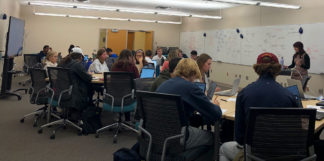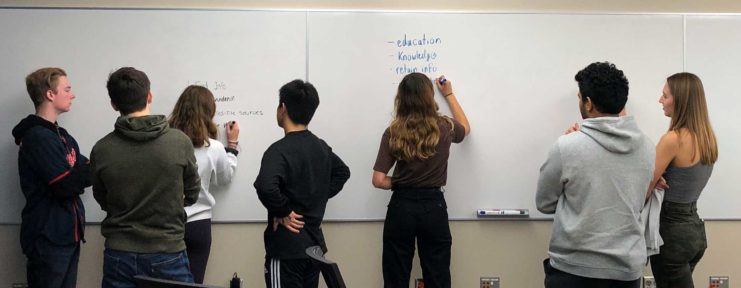Library instruction lab supports teaching evolution
By Jon Jeffryes
“No, you actually can use Wikipedia,” Mariya Gyendina reassures undergraduate students during an active learning exercise called Source Decks at Walter Library’s new instruction space.
Through this exercise and others, Gyendina, the Libraries’ Learning and Inclusion Strategist, helps students become active collaborators in learning. It also gives library instructors like Gyendina an opportunity to push back on misconceptions, creating moments of learning that transcend the classroom.
A new instruction space in Walter Library facilitates this active learning. It provides a space that supports librarians as they adapt their teaching to align with best practices.
‘Flexibility, accessibility, and student learning’
Library instruction used to be mostly step-by-step demonstrations of how to search databases. These classes took place in large labs with students facing forward as a librarian projected their screen and showed them how to navigate a search interface.
Then library instruction began to change, as librarians adapted their approaches to best meet student needs. Classrooms were flipped and librarians ceded the front of the room to guide self-exploration and discovery as students navigated databases on their own and taught their peers lessons from hands-on experience.
But while teaching methods changed, the physical layout of instruction labs stayed the same.
“They’re all very fixed and in a sort of teacher-centered way that’s not conducive for active learning,” says Gyendina.
 Seeking a solution that better facilitated these active learning experiences the Libraries evaluated its spaces and discovered an underused staff space in Walter Library’s Room 320 and transformed it into a student-centered space.
Seeking a solution that better facilitated these active learning experiences the Libraries evaluated its spaces and discovered an underused staff space in Walter Library’s Room 320 and transformed it into a student-centered space.
The new space seats up to 40 students and the furniture and technology are mobile and flexible, allowing for a wide variety of classroom layouts and use cases.
“One of the core tenets of the space is that technology doesn’t drive the space, pedagogy does,” says Lindsay Matts-Benson, Instructional Designer, who co-chaired a a team of library experts to design the space, which included Gyendina and Jody Kempf, Coordinator for Instruction and Outreach at Walter Library, and others.
The room includes white boards along all the walls, tables and chairs on wheels, and mobile monitor screens that students can connect to for projection.
“We really thought, ‘What do we want to do to help student learning?’” Matts-Benson explains. “Everything we got for the room was about flexibility, accessibility, and student learning.”
Examples of active learning
The new space allows librarians to expand their repertoire of active learning exercises and techniques. Examples include:
- KWL: This exercise starts with students going to the white boards and writing what they know about library research (K) and what they want to learn from the day’s session (W). Then at the end of the class students return to the white board to record what they learned (L).
- Source Decks: Librarians break the class into groups. Each group gets a stack of sources they might find in library research and are asked to rank the sources from best to worst. The class comes together as a large group to share their thinking.
 Active learning allows for engagement in higher level thinking for students than traditional database demonstrations.
Active learning allows for engagement in higher level thinking for students than traditional database demonstrations.
“It helps us get into these really interesting conversations,” says Gyendina “‘Is name recognition important?’ ‘How important is it?’ ‘What is peer review?’ How does it work?’”
Puzzling through questions like these prepare students for the critical engagement they’ll need when encountering information sources on the internet and social media. The exercises also allow librarians to see what assumptions and expectations students are bringing to the classroom.
‘Looking at that space made us re-examine our other spaces’
The Libraries continues to investigate the interplay between instructional space, educational approach, and student learning in their instructional program. The successful transformation of this space has sparked even more questions and thoughts for improvement.
“Looking at that space made us re-examine our other spaces,” says Kempf, “What kinds of spaces do we actually want? What would be useful? Are there use cases for different sorts of spaces?”





